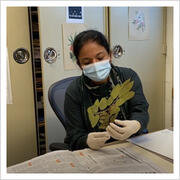
Saima Javed’s journey to the Herbaria began at the Harvard Museums of Science and Culture gift shop in 2003 where she worked as a clerical technician for almost five years. The HUH was fortunate to bring her onboard in 2008 as a curatorial assistant preparing and restoring vouchers for scientific studies. Away from the HUH, Saima loves to cook, spend some spare moments in calligraphy, and keep up with current affairs.
When did you first became interested in botany?
Since my childhood I have been near to nature. I remember planting seeds of mangoes and dates in our concrete veranda where only one small patch of land was left for planting. I used to dry roses and jasmine flowers in literature textbooks.
Where did you gain your educational foundation?
I completed both my Bachelor of Arts and Science and master's degree in Food and Nutrition at the University of Peshawar in Pakistan.
How did you get to where you are today?
It is an ongoing roller coaster in a very positive manner; new challenges, updated data and information, and preserving history for current and coming generations make it an extremely joyful journey. When I initially started [at the Herbaria], I felt it would be challenging to keep up-to-date with new knowledge and so I built up a library. With time, it became more manageable and exciting being proficient and just doing my job. I am happy to be where I am today, already giving nearly a decade of my life to something I want to do for the rest of my life.
Did you have a mentor(s)?
I grew up in a joint family system where I was very close to my uncles and aunts. Everyone was an intellectual. They always had various discussions on world politics, current affairs, education, entertainment, sports, etc., and I was always fascinated by listening to their conversations and arguments. I remember they always talked about two famous universities: Oxford and Harvard.
Edith Hollander is one of my most inspirational mentors. She was a longtime mounter at the Herbaria and a concentration camp survivor. I am fortunate to have spent many years with her and learned so much from her. I will never forget her dedication to work, her bravery, honesty, care, and love for my family and me.
Do you have a specimen that is the most cherished?
I have mounted and repaired thousands of specimens, all of which are unique and special for me. A highlight over the years was restoring Henry David Thoreau's specimens, transporting me to the time he spent collecting plant specimens and his cabin life. One of my all-time favorites from his collection is Bidens chysanthemiodes [B. Laevis].
Our own David Boufford's collection is also very dear to me.
What was your most exciting discovery so far?
I was very excited to mount Titan Arum, grown and bloomed at Harvard's Green House. And when I repaired specimens from E.O Wilson, I mounted the world's tiniest flower on a herbarium sheet!
What is something you have found particularly challenging?
It is always a challenge when students or visitors require answers that either is updated information regarding specimens or types or about old specimens and I have to jog my memory. Those rare moments help me study my work and it becomes a profound experience to answer to students or visitors.
What would you like the next generation to seek out?
I want to see kids near nature, spend time exploring their surroundings, and be fond of reading.